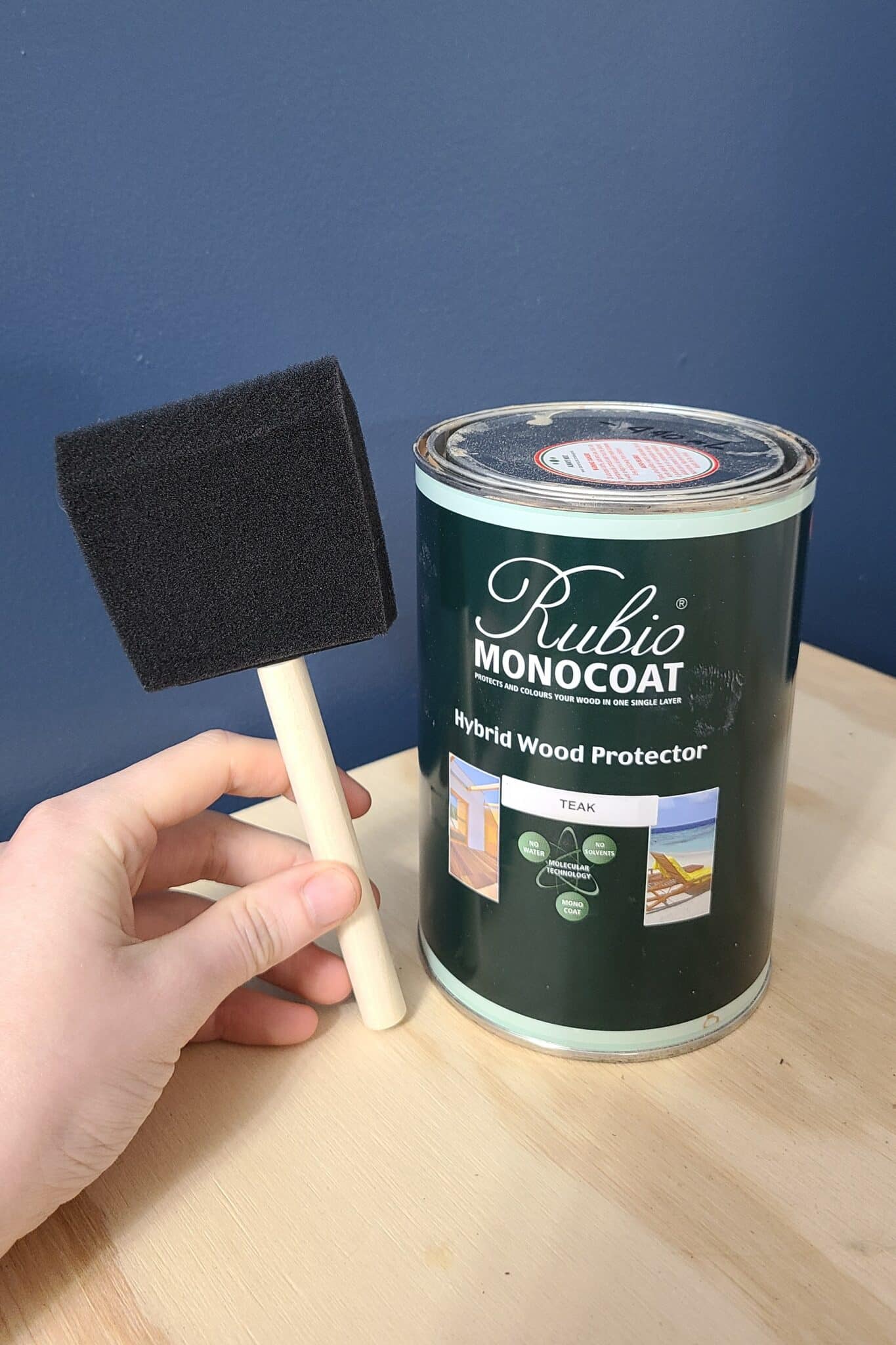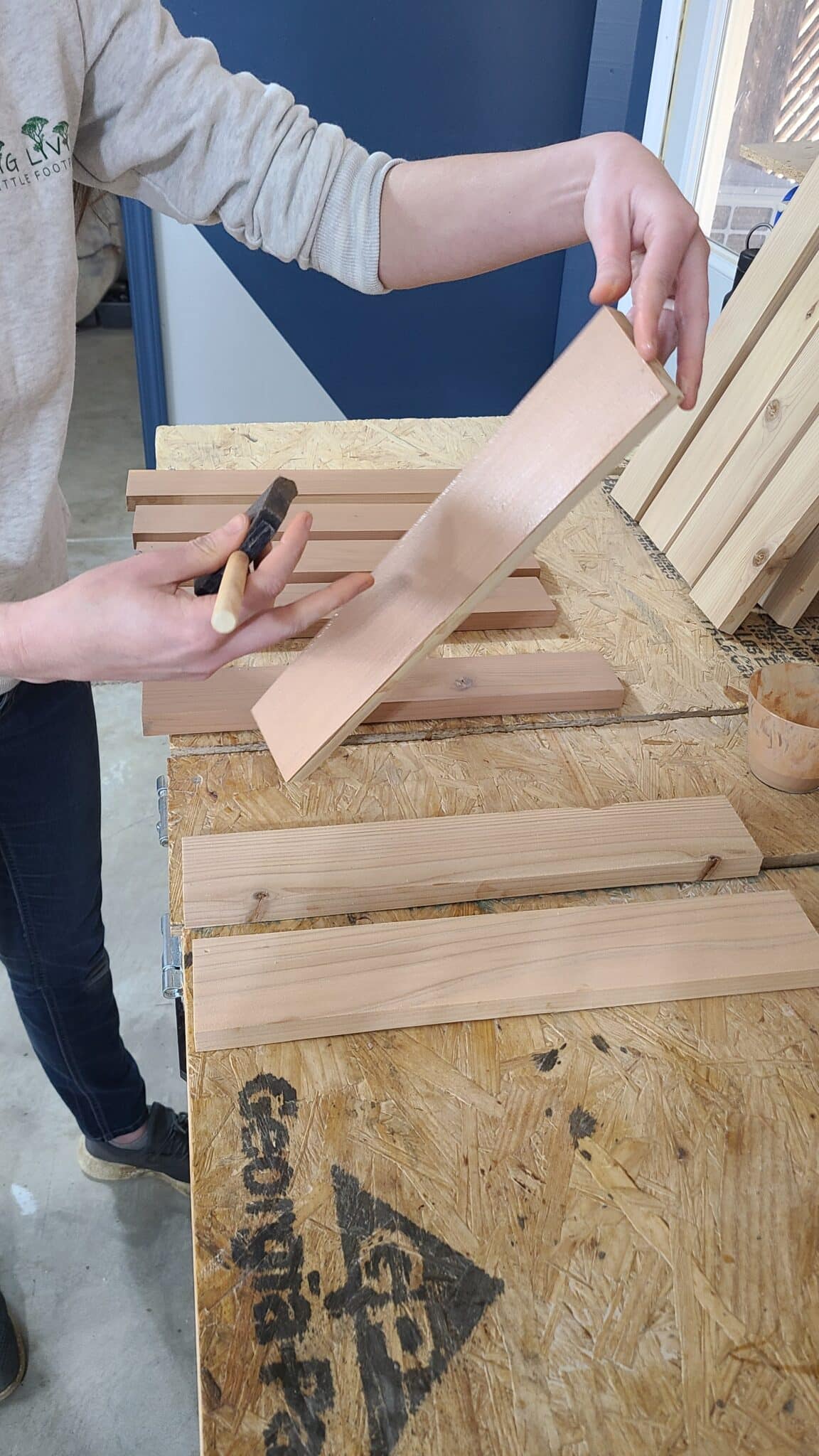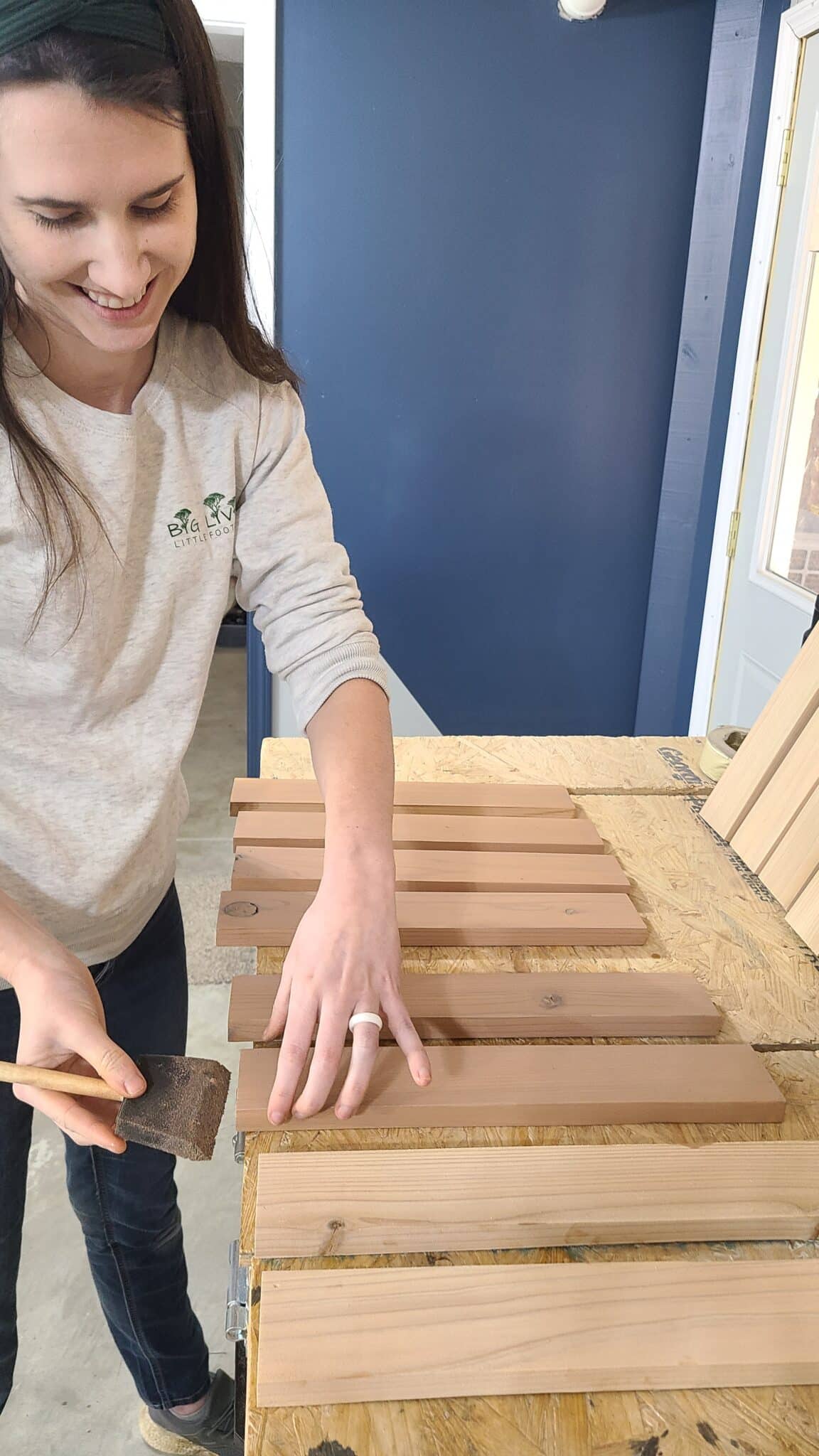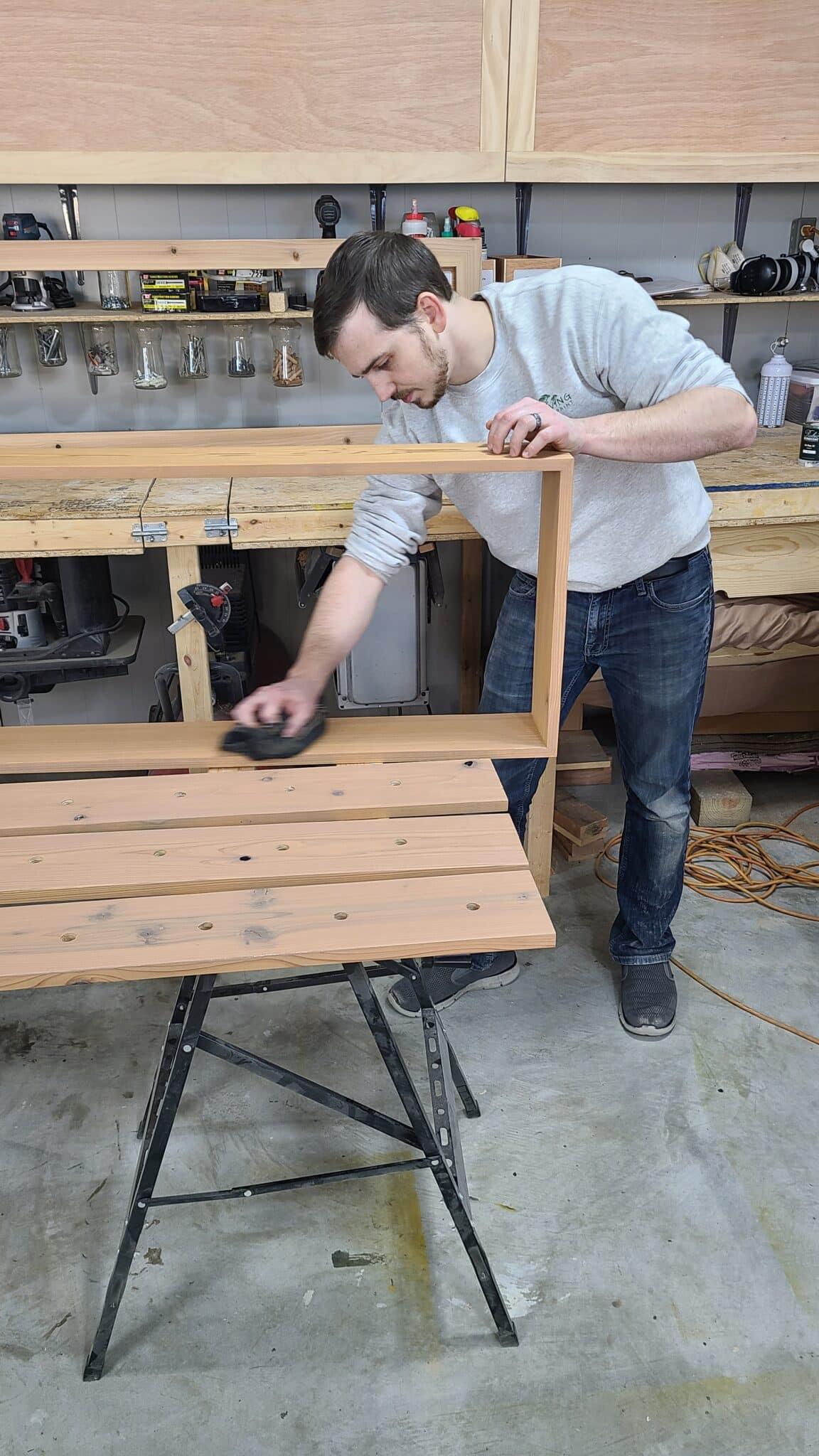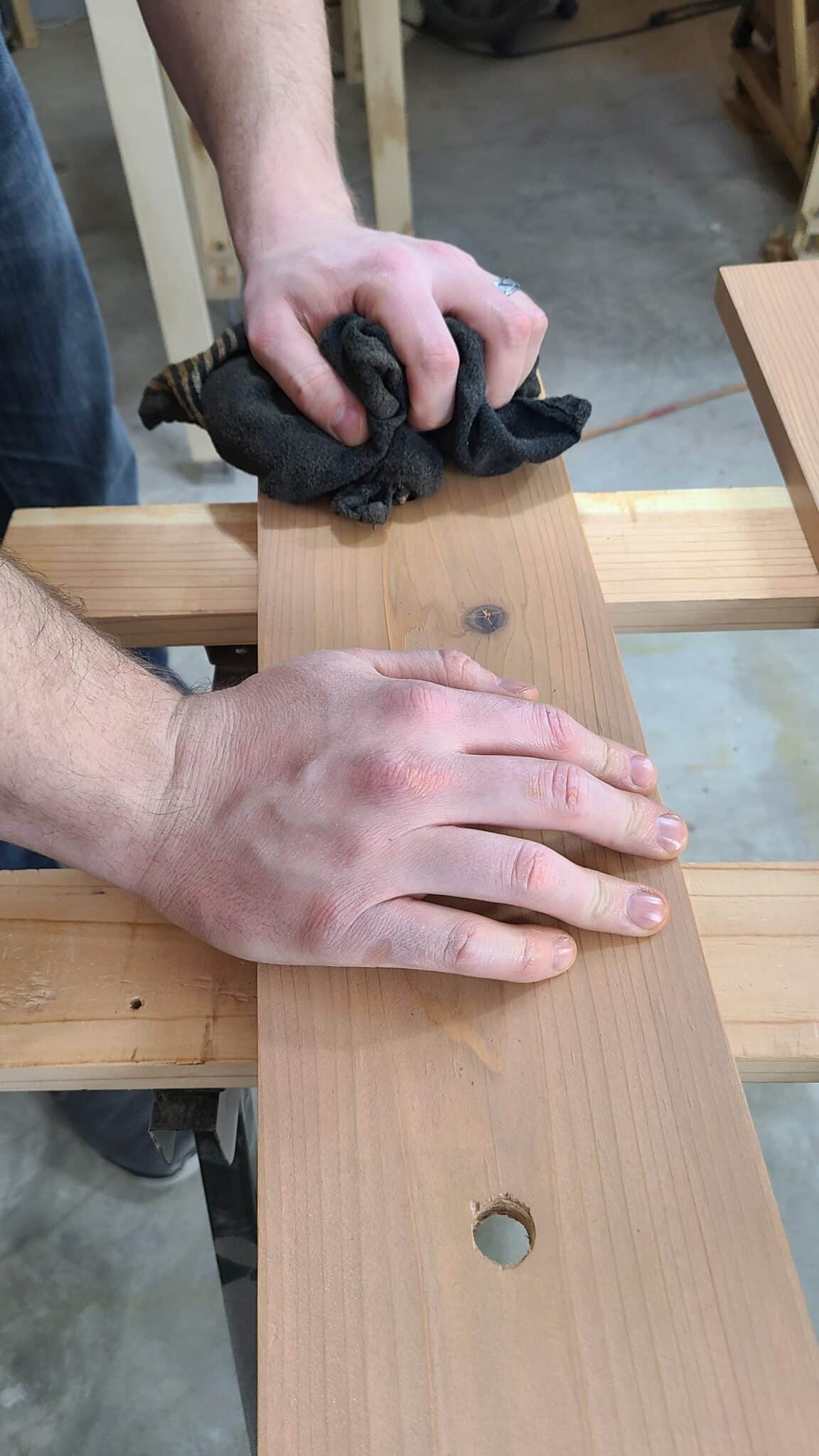Rubio Monocoat’s Hybrid Wood Protector: The Most Beautiful Exterior Wood Finish
Selecting a wood finish for an outdoor project can be difficult as you want it to look good and last a long time. For a beautiful wood look, we’ve found that Rubio Monocoat’s exterior products are unmatched. This post covers our Hybrid Wood Protector review and takeaways as well as the basics and application of the product.
Updated 4/04/2024

Disclaimer: This post includes affiliate links, and I will earn a commission if you purchase through these links. Read about our privacy policy.
As serial DIYers, we inevitably use a range of products when it comes to our DIY projects. Lately, we’ve fallen in love with the Rubio Monocoat brand products. If you know the Rubio brand, then it’s likely because you’ve heard of their Oil Plus 2C, which is the ultimate wood finish for us.
Whether or not you’ve heard or tried Rubio’s interior finish, you might be wondering about what to use for pieces that are outdoors and exposed to the elements. Well luckily, Rubio also has some exterior finish products: Hybrid Wood Protector and WoodCream.
We recently tried the Hybrid Wood Protector on our rebuild of our DIY Planter Box. Let me tell you, we love how it turned out and are super excited about how it will hold up. However, the application and final look are different from Rubio’s Oil Plus 2C look. So in this post, we’ll cover what the Hybrid Wood Protector is, the difference from the other products, when to use it, how to apply it, and our takeaways from using it ourselves.
What is Rubio Monocoat’s Hybrid Wood Protector?
Firstly, let’s cover the basics of Rubio Monocoat’s Hybrid Wood Protector. It’s a hardwax oil wood finish that uses molecular bonding to quickly adhere to the wood fibers and requires only one layer of finish to protect the wood. It creates a semi-transparent look where the wood grain is still very visible underneath one of the 22 colors available. Lastly, it can be used for both vertical and horizontal wood surfaces.
Now here are a few more reasons why this exterior wood finish is unique and why we love it.
Molecular Bonding & Hydrophobic Finish
Rubio is unique for its molecular bonding component with its finishes. Why is this so cool?! Because it means the oil adheres to the wood fibers within minutes making it easy to handle and you don’t have to wait for hours for it to dry to apply on the other side. Moreover, it also means there’s no need to build up plastic layers on the wood as many traditional polyurethanes do. The molecular bonding also keeps the natural look and feel of the wood without a filmy topcoat and multiple layers.
The Hybrid Wood Protector’s hydrophobic quality is another unique component of the product, which makes it great for exterior use.
Exterior & Interior Use
The Hybrid Wood Protector can be used for interior applications as well. But I would only consider this if you truly need a hydrophobic finish such as wood components in a bathroom or kitchen worktops. Rubio states that you’ll have to add 10% accelerator to the product though as these items are intensively used. Otherwise, the Oil Plus 2C is the ultimate interior wood finish in our opinion, and should be used instead if you don’t need the hydrophobic quality.
Sustainability Component
Rubio Monocoat’s products are a special oil base made from linseed oil with no water or solvents. So it’s a great way to DIY sustainably as it emits 0% Volatile Organic Compounds (VOCs) when used, unlike other stains and paints. This means no chemical substances are evaporating into the air when used. VOCs can be harmful to people, causing allergic reactions or breathing problems, and harmful to the environment by affecting the ozone and increasing the greenhouse gas effect. Rubio Monocoat accomplishes this through its molecular bonding process, which is so cool!
Rubio Monocoat is committed to 0% VOCs and has independent labs review and certify their products. You can view all of Rubio Monocoat’s certifications on their site.

Difference From Oil Plus 2C
The biggest difference from Rubio’s Oil Plus 2C product is the physical application and hydrophobic quality for exterior use. While the Oil Plus 2C withstands water, you wouldn’t want to just leave water sitting on a piece with that product applied. I haven’t personally tested it, but I’m sure the outcome would be similar to getting rings from a cup on a table and just damage the finish. That said, the finish is protective so if the wood with the Oil Plus 2C gets wet, then it’s fine for a short time as long as it gets wiped off, and Rubio makes repairing their finish very easy.
The Hybrid Wood Protector has a hydrophobic component to it. This simply means that the finish repels water, thus protecting the wood from being oversaturated with water causing it to age faster. This makes it a better use for exterior projects that need protection from the elements.
The other difference is in the physical application of the product. With Oil Plus 2C, you pour it on, spread it around and then buff it in by hand or with a buffer. With the Hybrid Wood Protector, you apply it with a brush, let it sit, and then wipe off excess product with a cloth.
Hybrid Wood Protector Vs. Wood Cream
We’ve been talking about the wood protector, but Rubio actually has two exterior wood finish products currently. Both products will give a different finished look and feel and are best used for different applications. Here is a breakdown of the difference between the two exterior products.
| Monocoat Hybrid Wood Protector | WoodCream |
| Oil-based | Wax-based cream |
| Semi-transparent Look | Opaque Look (can be diluted for transparency) |
| Monocoat = one coat colors/protects | Needs one or more layers to color/protect |
| For Vertical & Horizontal Surfaces | For Vertical Surfaces ONLY |
| Brush on, wait, and remove excess with cloth | Just brush on like painting |
| Available in 22 colors | Available in 27 colors |
| Cannot be diluted | Can be diluted with WoodCream Softener |
The Hybrid Wood Protector will expose more of the natural wood grain and can be used on both vertical and horizontal surfaces. The WoodCream can only be used on vertical surfaces and has a more painted, opaque look. However, Rubio states you can dilute the WoodCream with their WoodCream Softener to give the wood a more aged, transparent look. So depending on your DIY project and the final look you’re going to have to decide which option makes more sense to use.

How To Use Rubio Monocoat Hybrid Wood Protector
The process of using the Hybrid Wood Protector is a little different than if you’ve used Rubio’s Oil Plus 2C. But it’s still just as easy!
First, always sand down your wood to a fine grit and then clean the wood off. Also, make sure the wood is completely dry from whatever you use to clean it. Rubio has an exterior wood cleaner and interior raw wood cleaner they recommend. We simply use mineral spirits, but give it a full 24 hours or more to dry before application.
Application Process
Applying the Hybrid Wood Protector only requires a few simple steps:
- Step 1: Stir oil thoroughly and measure out the amount needed. Add 10% accelerator if your situation requires it.
- Step 2: Apply Hybrid Wood Protector with a flat brush
- Step 3: Let sit for 10 minutes (set a timer as that’s easiest to remember)
- Step 4: Use a flat brush to smooth the surface again without applying any new product.
- Step 5: Let sit again for 5 minutes and then wipe off excess product with a rag.
- Step 6: Leave it to dry. It will be dry in 24 hours and fully cured in 7 days.
You can touch it and work with it after 24 hours, but it’s best if you don’t. For example, we could have assembled the DIY planter box after 24 hours, but definitely didn’t want to fill it with soil and plants until it was fully cured. The same thing is true with Rubio’s Oil Plus 2C. We used it on our live edge floating shelves and hung them up after 24 hours, but didn’t really use them until they had fully cured later that week.
According to Rubio, below is what you can expect from the Hybrid Wood Protector:
- Spread Rate: 250-300 Sq ft/L
- Cure Time: 7 days
- Shelf Life: 36 months
What We Learned About Hybrid Wood Protector
So every product is slightly different. We always want to provide notes on what we learned from us personally using the product and our takeaways. Here are some items to note for Rubio’s Hybrid Wood Protector.
A Little Goes A Long Way – It’s Worth The Price
The price at first can be a little shocking, honestly. I mean around $165 for one Liter seems steep if you think of that compared to typical stains and topcoats you buy at local home improvement stores. BUT a little goes a long way with this Rubio finish and it only requires one coat. Other wood stains can require multiple coats and usually require a topcoat, especially for outdoor use. Moreover, they often require reapplication after a few years. That adds up in cost and time spent applying.
The monocoat only needs to go on in one layer and can last indefinitely if properly cared for, according to Rubio. Not to mention the quality of the finish is, in our opinion, unmatched by others we’ve tried.
For our 6’ planter box, we only used a little over ⅓ of a Liter. Which means we’ll be able to use that one Liter of Teak colored Hybrid Wood Protector for several DIY projects and get a cohesive look across all of them. So it’s worth the price in our opinion as a little goes a long way!
The Pure Is Not Really An Exterior Option
A key thing to note when looking at the Hybrid Wood Protector’s colors is that the Pure does not contain UV stabilizers. Many people might want to lean towards Pure as it is non-pigmented and brings out the natural wood tone with a warmer undertone due to the linseed oil base. But for exterior applications, it’s basically not an option in our minds.
This is because it doesn’t contain UV stabilizers, so it will not provide color stability against the natural aging of wood. For example, if we had used the Pure color with our cedar planter boxes then the natural graying effect of aging cedar would have still occurred in a few years. Our goal was to not have that gray effect, so we needed a product with UV stabilizers to help hold the color.
We chose the Teak color as it had UV stabilizers and was the closest to cedar’s natural color. The Natural color is another great option that is pigmented with yellow/white tones, has UV stabilizers, and stays fairly close to the natural wood color if it’s a lighter-colored wood. Check out our color test with the Oil Plus 2C product to get a better idea of how the colors can change the look of the wood based on species.
However, all that said, with some DIY projects the natural aging and effects of wood are the desired aesthetic. So go ahead and use the Pure! It’s all about how you want it to look in the end.
It Takes A Little More Time – But Less Than Traditional Finishes
As I mentioned, the application process is straightforward and easy. However, if you have a lot of boards or surface area to cover, it can take a little more time to apply than if you’re used to the Oil Plus 2C process.
For example, on a larger project, it’ll likely take you more than ten minutes to brush the first coat onto every board. Which means you’ll either need another pair of hands to do the second dry brushing or you have to do the application in smaller batches. Not a big deal, but the time factor means you have to keep track a little more. We just used a timer (aka our google mini speaker) to set the specified time and worked in small groups of boards, which helped a lot.
But unlike traditional stain, you don’t have to wait multiple hours for the product to be dry before you can touch it and flip it over. And you won’t have to wait hours between top coats, while hoping no dust or hair falls on your piece! You can apply the wood protector on the other side as soon as the excess product is wiped off of the first side. So it takes much less time than traditional finishes.
Don’t fret and stress out about it, if everything isn’t “timed” perfectly. As long as you go through the brushing and waiting process, and then make sure to wipe off any excess product at the end, it’ll turn out fine. I know there were several times when a few extra minutes went by before we could brush or wipe off the excess product and it still turned out beautifully (we have a toddler running around the shop who loves to distract us!).
Accelerator May Be Needed
When applied to high-use surfaces, Rubio recommends mixing in 10% Oil Plus Part B, prior to application. This is an accelerator (Oil Plus Part B) that helps to harden the hybrid wood protector and make it more durable. Since we were using this on our planter box, Rubio recommended that we use this accelerator to better protect it from the moisture of the soil.
This accelerator wouldn’t be required on most outdoor pieces, but it would be a good idea to use it on flooring, work surfaces, or anywhere that is in contact with the ground.
Accelerator doesn’t come with the Hybrid Wood Protector like it does if you buy Oil Plus 2C. You have to purchase the accelerator separately. However, if you have bought some of the Oil Plus 2C previously, you can steal a little accelerator from that can and use it with the Hybrid Wood Protector.
Rubio Monocoat – Where To Buy
You can buy Rubio’s Hybrid Wood Protector finish from several places. Personally, we’d recommend buying directly from Rubio as you have all the options available and the shipping is usually fairly quick.
- Directly from the Rubio Monocoat – Their website allows you to get any color in either 20ML, 100ML or 1 Liter. Bonus, they provide FREE shipping within the U.S.
- Buy from Amazon – great fast, shipping, but not every color is available or can be bought in all sizes on Amazon. Sometimes it’s also more expensive.
- Purchase from a local dealer – Only found in a few cities and not every dealer has every color and size available.
Hybrid Wood Protector FAQs
Because we’re naturally inquisitive people, we tend to always ask a lot of questions. So here are some typical questions you may be asking yourself in regard to Rubio Monocoat and the Hybrid Wood Protector product.
Is Rubio Monocoat linseed oil?
Yes, Rubio Monocoat uses linseed oil as the base for its oil-based products. They wanted to develop a product that was safe for the user and their environment. This leads to their oil containing 0% VOC or water.
Can you use Rubio without accelerator?
Yes, Rubio’s products don’t typically require the accelerator. For the Hybrid Wood Protector, it’s fully cured in 7 days and the accelerator is only recommended when using on high-use surfaces. For the interior Oil Plus 2C – Part A with no accelerator it would be fully cured in 3 weeks instead of 7 days with the accelerator (Part B). There are cases where Rubio recommends the accelerator, so always double-check what works best for your situation. Personally, the accelerator is worth it to help speed up the curing process!
Does Rubio Monocoat need a topcoat?
Nope, that’s why it’s called “monocoat”. The single layer of oil protects and adds color at the same time, so there’s no need for a topcoat finish. Actually, the monocoat products will not bond to itself, so doing multiple coats is not needed.
How often do you have to recoat Rubio Monocoat?
According to Rubio, a wood surface that is finished with Rubio Monocoat’s hardwax oil can last indefinitely when cared for properly. There’s more about Rubio Monocoat maintenance in our review post.
Does Rubio Monocoat block UV?
Yes, Rubio Monocoat’s Hybrid Wood Protector combines their zero VOC hardwax oil technology with UV protection against UV radiation and wood rot. It keeps the wood looking fresh and new like when you finished the project.
More DIY Projects
Now that you know everything about Rubio, it’s project time, right!? At least, that’s how we would feel. So check out more of our DIY projects articles for inspiration!
- Hubby How To: DIY Planter Box
- How To Make DIY Floating Shelves – Live Edge Wood Shelves For Kitchen
- 15 Awesome DIY Projects At Home You Can Do
- Hubby How To – Modern DIY Platform Bed Frame
- Hubby How To – DIY Modern Headboard With Floating Nightstands
Hope you try this product and love it as much as we do! Let us know what you think of the Hybrid Wood Protector and what projects you’ve used it for in the comments below!


Disclaimer: This post includes affiliate links, and I will earn a commission if you purchase through these links. Please note that I’ve linked to these products purely because I recommend them and they are from companies I trust. There is no additional cost to you.

